Do All Basement Walls Crack? Causes, Symptoms, and When to Worry.
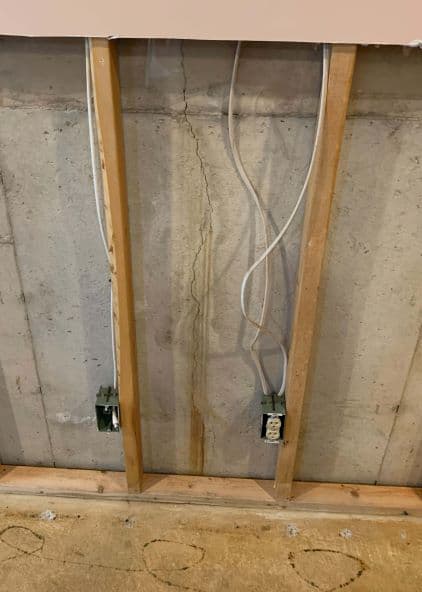
Concrete is an essential building tool. It’s a man-made concoction that literally paves the way for our society. We use it to create roads, bridges, retaining walls, dams, and even our homes. It’s everywhere and we rely on it heavily in everyday life.
Nothing in life is infallible, though. And when you consider the amount of stress that a concrete foundation has to endure while supporting a fully furnished home in ever-changing seasonal conditions…. Cracks in your basement walls seem inevitable.
Founded in 1996, Acculevel has been helping homeowners restore health and stability to their homes for decades. We use products and materials that are designed specifically for use with concrete foundations, and most of those repair methods come with a life of structure warranty.
Throughout our nearly thirty years in the industry, we’ve resolved foundation issues for more than 35,000 Midwestern homeowners. Like you, they had questions about cracks in their foundations. In this article, we’re going to explain the three major types of foundation cracks, what causes them, and how to repair them.
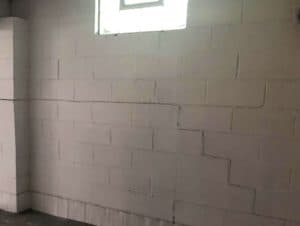
This photo was taken by an Acculevel project advisor during a routine home evaluation. This basement wall has developed multiple cracks that are now a structural issue.
Why Do Basement Walls Crack?
We mentioned that your foundation endures a lot of stress from environmental forces. These can be everything from erosion and frost heaves (when water in the soil freezes and expands) to flooding and drought.
None of these are circumstances you can avoid or control because they originate with natural events like heavy rains, dry spells, and freezing temperatures.
Why Is Crack Repair Essential?
Since basement wall cracks are a common occurrence, you may be tempted to take a casual approach to their repairs. But this is not a wise move because ignoring any developing damage —even minor cracks — can lead to a serious structural problem.
Cracks in your foundation will not fix themselves. They will only widen over time. Foundation wall cracks can lead to more cracks, wider cracks, water intrusion, leaning walls, and eventually structural damage.
There are a variety of ways you can fix cracks in your basement; the best method depends on the source of your foundation problem. We’ll begin with the least damaging type: hairline cracks.
What’s the Best Repair Method for Hairline Cracks?
The most common — and least troublesome — cracks are “hairline” cracks. They’re called this because they are extremely thin and don’t form in a specific shape or direction. These are normally fixed either by applying or injecting an epoxy.
Acculevel has used both methods.When we started foundation repair, we used the injection method. Ultimately, we determined this was not the best option for us or our customers.
How Epoxy Crack Injections Are Done
This type of repair begins with inserting injection ports into the crack. These ports work like funnels, directing the fill material (a type of epoxy, caulking, or sealant) into the crack. The ports have to be placed every 6-12 inches. The injection tool forces the fill material through the port into the crack until the next port is reached. The “full” port will be capped to close it, and they move on to the next one. This process is repeated until the crack is filled.
The ports cannot be removed until the crack fill material has completely dried. This can take a few days, or a few weeks, depending on the humidity in the space.
Why Acculevel Stopped Using the Injection Method
The repairs were inconsistent because the ports often interfered with the fill process. Placing these ports limited the view, making it harder for the repair crews to gauge how much fill material was in place and if it was a sufficient amount.
The ports also left holes in the concrete, which customers didn’t like, and we felt was counterproductive. (We’re there to repair a crack, but we’re leaving holes behind?) But the ultimate reason we stopped using the injection method was the fact that these repairs did not work as well or last as long as we believed they should.
How Epoxy Crack Repair Works
Acculevel replaced the injection method with epoxy fill. We are much more confident in this process, and warranty our crack repairs for five years.
The crack is lightly sanded to create a more textured surface. This allows better adhesion for the epoxy. The epoxy is applied to the entire crack, and on either side of the crack for a few inches.
 This photo was taken by an Acculevel crew member before an interior crack repair.
This photo was taken by an Acculevel crew member before an interior crack repair.
The epoxy we use is more flexible than standard caulking or crack fill. This means that the epoxy can adapt to seasonal changes in your foundation and maintain a tight seal. You can learn more about our epoxy method and its results here.

This photo was taken after the epoxy repair was completed.
Stair Step or Horizontal Cracks Need Prompt Attention
Unlike the spidery, unpredictable lines of a hairline crack, the cracks caused by hydrostatic pressure form in specific patterns. Your foundation material can determine what pattern you see.
In poured foundations, you’re only watching for long horizontal cracks. In concrete block foundations, you might see long horizontal cracks or cracks that follow the mortar lines between the blocks. Depending on what region you’re from, these can be called zig-zag or stair step cracks.
No matter which shape you discover, these basement wall cracks need to be addressed as soon as you discover them. These are both serious structural cracks in your foundation wall.
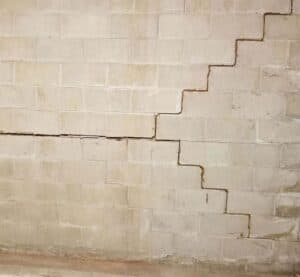
This photo was taken by an Acculevel project advisor during a free estimate appointment. Both horizontal and stair step cracks have formed as the wall bows under pressure.
What Is Hydrostatic Pressure?
This is a term commonly used in our industry to describe the lateral pressure that forms when the ground around your home is saturated with water. Essentially, once soil starts absorbing water, it expands, which presses against your foundation walls. Any excess water that can’t be absorbed also pools around your foundation, which is why these cracks often leak water into your basement.
Why Are Zig-Zag and Horizontal Cracks Urgent Concerns?
We mentioned that it’s lateral pressure from excess water that creates these cracks in a basement wall. Your foundation is designed specifically to resist vertical pressure, which comes from the weight of your home pressing downward. Your basement walls are not constructed to resist the outside pressure that develops during environmental changes like heavy rains and expansive soils.
Cracks caused by hydrostatic pressure demonstrate that the structural integrity of your concrete foundation wall has been compromised.
Left unattended, these cracks will do more than let in water. They’ll widen into gaps, then they’ll separate the wall into pieces that will bow inward and buckle. Eventually, your foundation wall may collapse entirely.

This photo was taken by an Acculevel project advisor during a routine home evaluation. The horizontal crack has widened and the wall is bulging inwards.
There are several different repair methods available for bowing walls. In order to choose the best method for your home, a foundation expert needs to evaluate how significantly the basement wall is bowing, as well as review the layout of your property. We evaluate these methods in detail here.
The best advice we can provide is to address this early on; the least expensive and least intrusive repair method, carbon fiber straps, is only an option for walls bowing less than 2 inches.
In most cases, we also recommend interior waterproofing to relieve the pressure that’s created the foundation issue. Your home and its surroundings should also be checked for improper drainage like clogged guttering or poor landscape slope. Many times, extending gutter downspouts to direct water farther from the foundation will reduce or even eliminate basement water intrusion.
Uneven Settling Causes Distinctive Crack Patterns
You’ll notice that we specified uneven settling in this title. This is because all homes settle; it’s a natural process that occurs when a home is built. The ground was disturbed when it was excavated, then it was packed down so that a large structure could be built on top of it. Over time, you added furnishings and belongings, increasing the vertical pressure even more. If you’re lucky, the foundation will settle equally across the property.
But you’ll have problems if the foundation settlement isn’t even across the home. When one section of your foundation sinks more than the others, it strains the materials that make up your home. None of the materials (concrete, wood, drywall) flex or bend; instead, wooden frames twist, and concrete cracks.
Now, cracks that are caused by settling problems are not as clear-cut as horizontal cracks running along a basement wall. They require a bit of detective work to accurately diagnose.
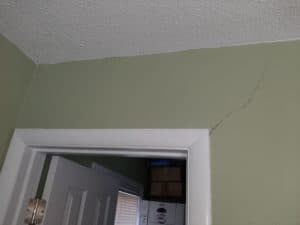
This photo was taken by an Acculevel project advisor during a home evaluation. This door was difficult to close, and you can see the drywall is cracking above the door frame.
How To Diagnose Uneven Settling Cracks
There are three major signs to watch for — and not all of them happen in your basement:
- Small cracks form in your drywall, especially around door or window openings.
- Those doors or windows will “stick,” meaning you will struggle to use them. They may not stay open without a prop, or won’t stay closed unless locked.
- Foundation cracks in the same area as the other symptoms — both inside and outside the basement.
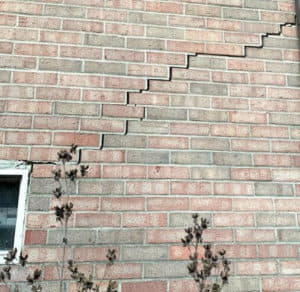
Another photo taken during a home evaluation — this type of exterior crack forms when one portion of the foundation settles and pulls against the rest of the home.
As we mentioned at the beginning of the article,all foundation cracks need to be fixed. But if you have settling foundation problems, first you need to stop the foundation from sinking any more than it has. The best way to restore stability to a settling foundation is to use helical piers. We discuss how piers work and what they cost in this article.
Please Don’t DIY Foundation Repairs on Your Home
It may be tempting to repair cracks forming in your basement wall yourself, but we strongly urge you not to do this. Caulking a bathtub is a very different process than filling foundation cracks.
Our project advisors are trained to evaluate and assess the cracks in your foundation. They can determine the cause of your foundation damage, and recommend the ideal whole-home solution that will protect and preserve your home.
We firmly believe our crews are the best in the industry; most of our crew leaders have been with us for 10+ years. In addition to all this experience and expertise? The materials we use are not available to the general public. Any fill kit or epoxy that you find in a big box store is going to be less effective and will not carry the kind of warranty that a professional contractor can provide.
Want to Learn More About Foundation Damage and Repairs?
If you have more questions about crack repairs, settling issues, bowing walls, or other potential foundation problems, check out our free comprehensive Foundation Repair Guide for Homeowners. This guide is regularly updated and is meant to be a resource for everyone who has questions about symptoms they’ve seen or experienced in their homes.
When you’re ready to have a contractor come to your house, please make sure you verify that any company you choose is reputable, insured, and accredited by the Better Business Bureau. Not sure what questions to ask or what information you should acquire about the company you hire? Please use our guide to questions you should ask a contractor, with a free downloadable form.
If you live in Indiana or the surrounding states, contact Acculevel. We are a family-owned and operated company, and we provide free written estimates. One of our experienced project advisors will evaluate the cracks in your basement wall and recommend the best course of action for you. Our goal is to help you keep your home strong and healthy for years to come.